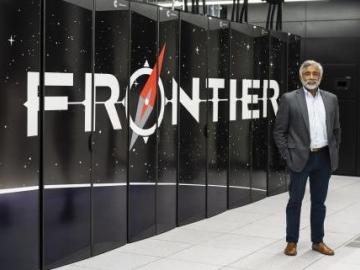
Filter News
Area of Research
News Topics
- 3-D Printing/Advanced Manufacturing (3)
- Advanced Reactors (1)
- Artificial Intelligence (4)
- Big Data (1)
- Bioenergy (2)
- Biology (3)
- Biomedical (1)
- Buildings (2)
- Chemical Sciences (9)
- Climate Change (1)
- Computer Science (4)
- Coronavirus (2)
- Critical Materials (1)
- Cybersecurity (1)
- Decarbonization (1)
- Energy Storage (12)
- Environment (2)
- Exascale Computing (3)
- Frontier (3)
- Fusion (1)
- Grid (2)
- High-Performance Computing (3)
- Machine Learning (2)
- Materials (13)
- Materials Science (6)
- Microscopy (2)
- Nanotechnology (3)
- National Security (2)
- Neutron Science (3)
- Nuclear Energy (1)
- Partnerships (4)
- Physics (5)
- Polymers (2)
- Quantum Computing (2)
- Quantum Science (2)
- Security (2)
- Space Exploration (1)
- Summit (1)
- Sustainable Energy (1)
- Transformational Challenge Reactor (1)
- Transportation (2)
Media Contacts

Marc-Antoni Racing has licensed a collection of patented energy storage technologies developed at ORNL. The technologies focus on components that enable fast-charging, energy-dense batteries for electric and hybrid vehicles and grid storage.

Using existing experimental and computational resources, a multi-institutional team has developed an effective method for measuring high-dimensional qudits encoded in quantum frequency combs, which are a type of photon source, on a single optical chip.

Researchers at ORNL and the University of Tennessee, Knoxville, discovered a key material needed for fast-charging lithium-ion batteries. The commercially relevant approach opens a potential pathway to improve charging speeds for electric vehicles.

Two years after ORNL provided a model of nearly every building in America, commercial partners are using the tool for tasks ranging from designing energy-efficient buildings and cities to linking energy efficiency to real estate value and risk.

When Hurricane Maria battered Puerto Rico in 2017, winds snapped trees and destroyed homes, while heavy rains transformed streets into rivers. But after the storm passed, the human toll continued to grow as residents struggled without electricity for months. Five years later, power outages remain long and frequent.

ORNL has been selected to lead an Energy Frontier Research Center, or EFRC, focused on polymer electrolytes for next-generation energy storage devices such as fuel cells and solid-state electric vehicle batteries.

Five technologies invented by scientists at the Department of Energy’s Oak Ridge National Laboratory have been selected for targeted investment through ORNL’s Technology Innovation Program.

The U.S. Department of Energy’s Oak Ridge National Laboratory celebrated the debut of Frontier, the world’s fastest supercomputer and the dawn of the exascale computing era.

ORNL Corporate Fellow and Center for Nanophase Materials Sciences researcher Bobby Sumpter has been named fellow of two scientific professional societies: the Institute of Physics and the International Association of Advanced Materials.

Scientists at ORNL used neutron scattering to determine whether a specific material’s atomic structure could host a novel state of matter called a spiral spin liquid.


